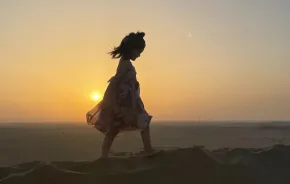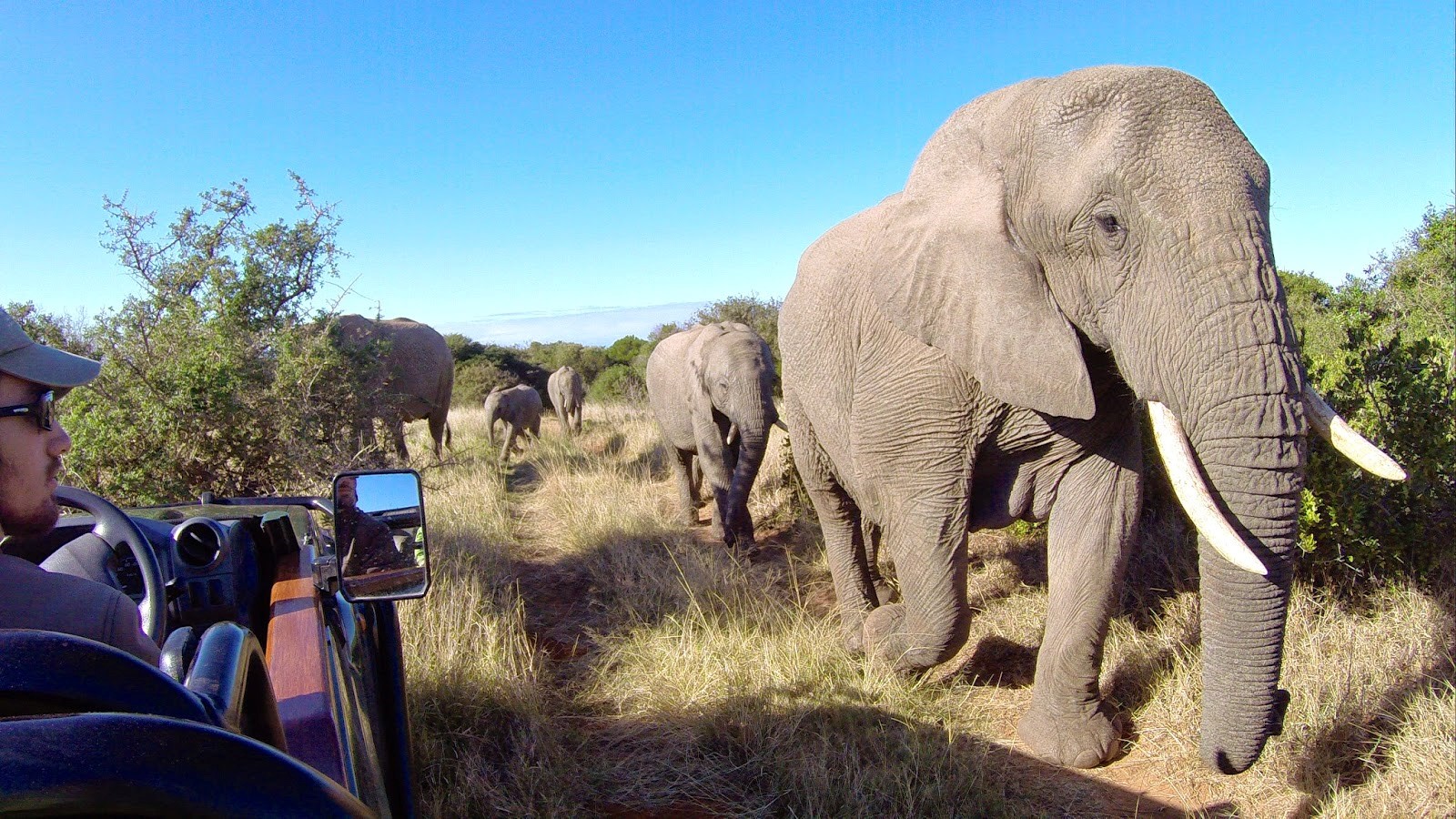
My husband, Ken, and I traveled to the Cape Town area of South Africa this past July. It involved a lot of planning, multitudes of logistics and heaps of grandparent karma as we would be leaving our two preschool-aged children with my family in Portland, Oregon. During our journey, we observed wild animals in native habitats on a boundary-pushing, comfort zone smashing, epic, two-week adventure. Here are excerpts from my trip journal.
During Discovery's Shark Week 2001, I watched a program called Air Jaws. The show documented the South African great white sharks that launch themselves out of the water to hunt seals. Up until that point in my life of avidly watching shark documentaries and being a shark aficionado, I had never heard of (or seen) such behavior. As the first few sharks leaped out of the water on screen, I stood up in my empty living room, pointed at the TV and screamed, "I am so going there someday!"
13 years pass.
July 29, 2014: Leaving the kids behind
Ken felt I had over-prepared when creating the binder and making the picture pillows for the children. I think he also felt that we weren’t allowing them to rise to the occasion enough and adapt to a new situation. But knowing that I had done everything to set up the children and my parents for success to be prepared for the worst-case scenarios, I could embrace this vacation without having my mind in two places. It’s sort of a detachment that has to happen and it’s strange as a parent because you can never really fully detach.
Day 1: Dangers of being in South Africa
I can’t help but think sometimes that we are dancing on the razor’s edge. There is inherent danger in every aspect of this trip. I occasionally wonder if we are reckless to have done this. But I suppose that is why we are here: to be challenged and remember how great it is to be alive. That makes us better parents and better people, right? Because wouldn’t it be worse to wait for a more opportune time, but risking that we might never fulfill this dream at all? I want my kids to dream big, take risks, trust. So, we should embody that too.
However when diving with Great White Sharks seems like the least dangerous aspect of your trip, you really do have to wonder. Especially when I read a bunch of travel books and the State Department advisory webpage which basically implies you're a big dummy to go travel around this country with "a very high level of crime." It also has “one of the highest rates of sexual assault in the world" and "several US citizens have been robbed at gunpoint" while "carjackings and thefts from cars are serious problems." Not anxiety-making at all. But I’m steadied by a number of close friends who just traveled here with no experiences like that. Obviously we will keep our guard up and be extra vigilant.
Today, our first full day in country, we heard rapid machine gun fire. For 30 minutes, we were freaking out in our room, thinking the worst and regretting this trip. Finally we just called our B&B host and emailed the shark tour office manager about it. They both told us not to worry, it was only target practice happening down at the naval base below our B&B. Routine. Happens all the time. Machine gun fire. Awesome.
Later we chatted with the four visiting students from University of Victoria and I slowly began to feel ridiculous about how scared we had been feeling about our personal safety. These kids had been working in-country for weeks and spent a long time in Johannesburg, a place South Africans think is very dangerous. They’d even ridden the train with expensive camera equipment with no issue and done what college students do: explore. As I told them about our life back home with children and our married, middle-aged concerns, I could see their eyes glaze over and it reminded me how big the chasm is between a ‘college upstart’ and a ‘mid-lifer on holiday.’ But it was a good thing because it shook me out of my fear and let me appreciate what we were experiencing.
Day 2: Getting in the cage
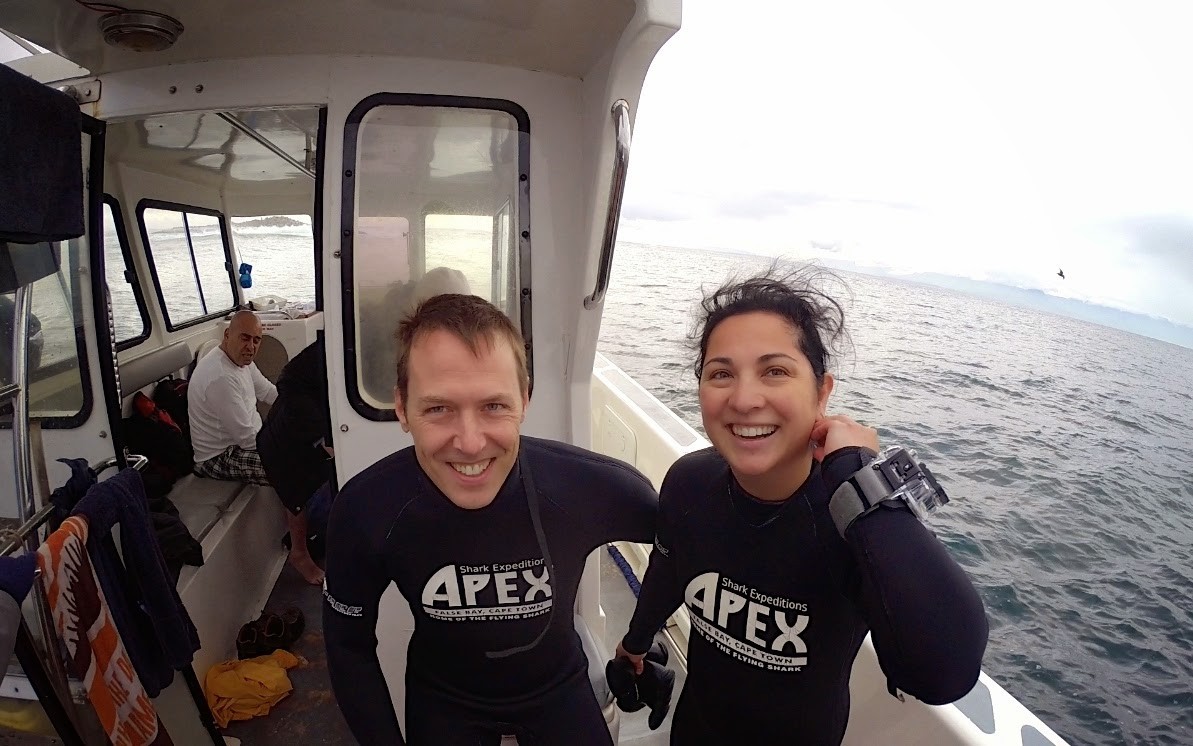
Getting on the boat we met the crew who were very knowledgeable, even-tempered and skilled. It’s definitely hard work organizing a group of crazy shark enthusiasts.
Dropping into the cage, you realize how rough the water really is. The snorkel only reaches up so high so if you put your face down too low, you suck in a mouthful of saltwater. I kept doing that and it made me a little leery of putting my face down in the water too far. But once I braced on the sides of the cage and got better idea of how far down my head could be, I started to enjoy it. The sharks cruised by and the visibility was very good. I wasn’t even scared like I thought I might be. I just wanted to reach out and touch one of the animals but I thought better of it. One of them actually bit the cage!
This moment has been 13 years in the making. It was an honor to be in the presence of these sharks and to see them in all their magnificence. I think we were in the cage for 20 minutes and the water was chilly but fine with a wetsuit. I was ready to get out, though, when our time came. The jostling inside the cage was the worst part.
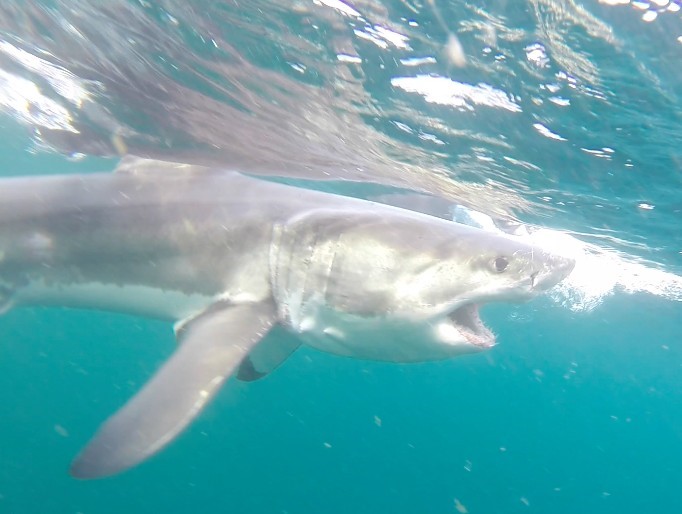
Day 3: Observing shark predation
Watching sharks hunt seals makes you appreciate the position they both hold in the food chain. The seals are actually not that meek or fragile. They are fast and armed with sharp claws as evidenced by scratches on the snouts and bodies of the sharks. Seals are very difficult to pierce but the sharks are armed with the one thing that slices through them like butter: teeth. They are a well-matched rivalry, as nature intended. The birds can sometimes be an indicator of a predation or a kill since they act like an audience at a crime scene — all gawking and wanting to get close. But then they pick up the scraps that the sharks leave. I saw some birds fight over a seal’s remains and strung his intestines out over the water. It was pretty gross.
Day 5: Sea sickness strikes the shark boat
Despite being out in the False Bay and not on the ocean itself, the waves and weather still come together to make some nasty swells. Today was one of those unfortunate days. A huge storm came in yesterday that canceled all the shark boats but we were hopeful today that the water would be calm. Well, it was not. The cage was tossing all over the place — I didn't even go in it. Ken braved it but then later, like most of the other guests, ended up losing his breakfast over the side. I managed to keep mine under control but barely. This is in stark contrast from last time we went out when things were pretty smooth. I reminded Ken that I felt like I was ‘on a boat’ when I had morning sickness with both pregnancies. That lasted on and off for a few months (each!) so a few hours of feeling nauseous didn’t seem that bad, actually.
Day 6: Our last boat
Luckily our last day on the boat was considerably less rough than the previous. We learned our lesson and took motion sick medicine. The magic combo is half of a sickness pill the night before and half right before going on the boat. Plus I had my Sea Bands, an aromatherapy stick and ginger lozenges. It was a bit cold in the water and pulling on wet wetsuits is like trying to put on wet, thick Spanx but the men were complaining the most. Typical.
I decided not to use a snorkel this time — only a mask. I held my breath and went down for looks. It made a world of difference. I didn’t swallow mouthfuls of seawater or feel so jostled and I had better stability since I had less to deal with. The visibility was murky though and the sharks were noticeably coming in at almost vertical angles on the bait instead of swimming completely horizontally as they did our first day. We saw a mix of males and females and a gigantic lunker of a shark that must have been about 12 feet long. Both Ken and I felt it was a fitting ending to the marine wildlife part of our trip. See our video below.
Day 7: Now for a safari
In transit to the game reserve, it occurred to me that we had just accomplished something pretty major: seeing and cage diving with great whites. This is something I’ve been dreaming about for years and we finally did it. It took over a decade of dreaming, a year of planning, hours of flying to the farthest land point on the planet from Seattle and then jumping into a cage of cold water beside one of Earth’s mightiest predators. I got a little teary and overcome thinking about it. I think sometimes as a parent and as someone who is 40 there is this erroneous idea that life is as good as it’s going to get. The time of doing anything crazy or surprising or risky is — or should be — over. Obviously, that’s not true, but I was becoming too complacent in my late '30s so it was time to shake things up.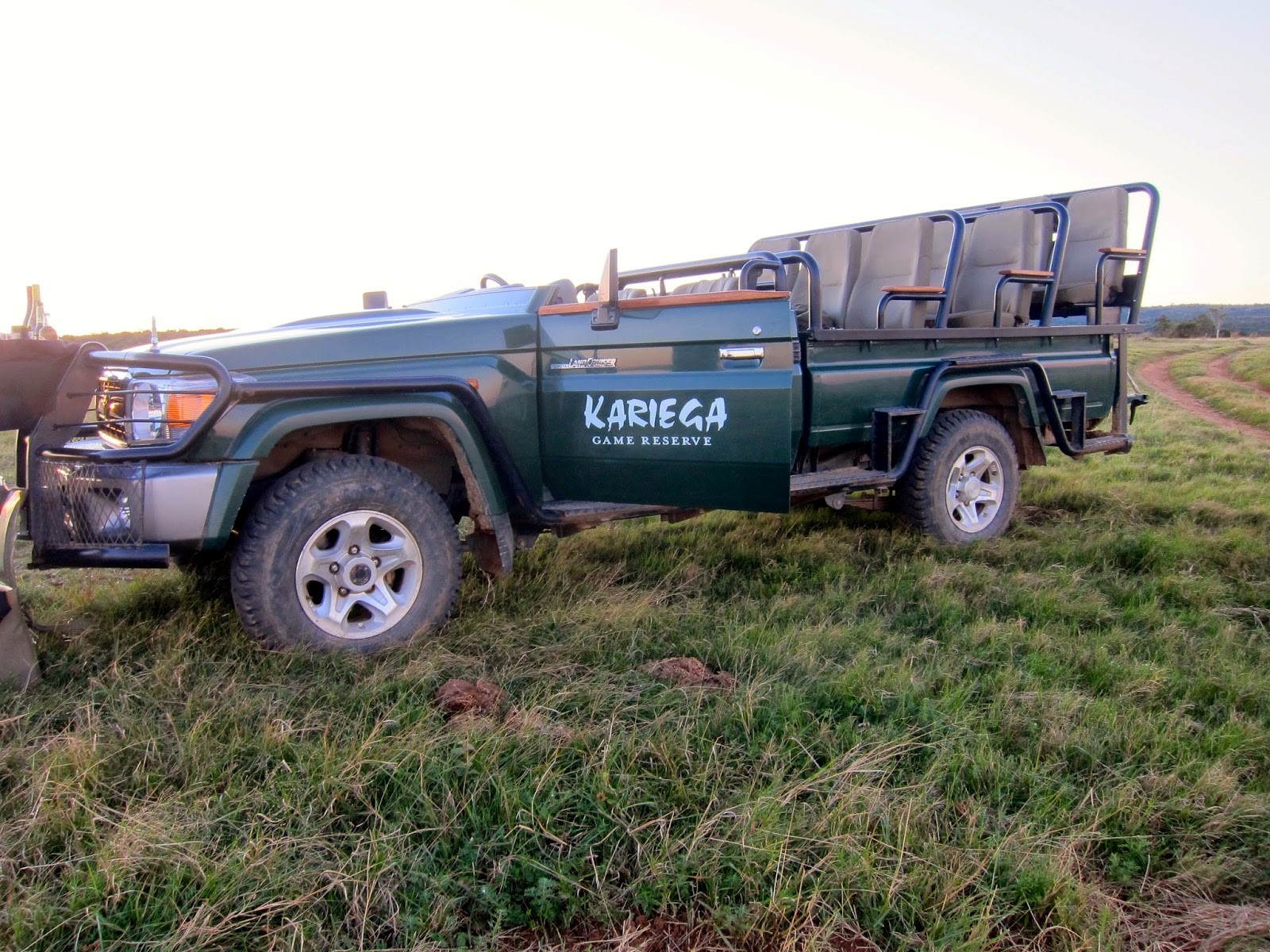
Moving on to the next wildlife adventure, Kariega Game Reserve is gigantic (roughly 22,240 acres). Our guide Louis picked us up at the gate house in the open air modified Land Cruiser that would be our jeep chariot for the duration. Five other guests joined us as we went out on the night drive, which began in the rain. Ponchos were distributed, but it was somewhat miserable with the wet, cold and wind together. Luckily, we encountered the resident male lion and followed him for a bit. Evidently the lions aren’t too easy to locate so that was a great find the first time out. At dinner we all tried ostrich. It tasted and looked like beef but with no fat or cholesterol.
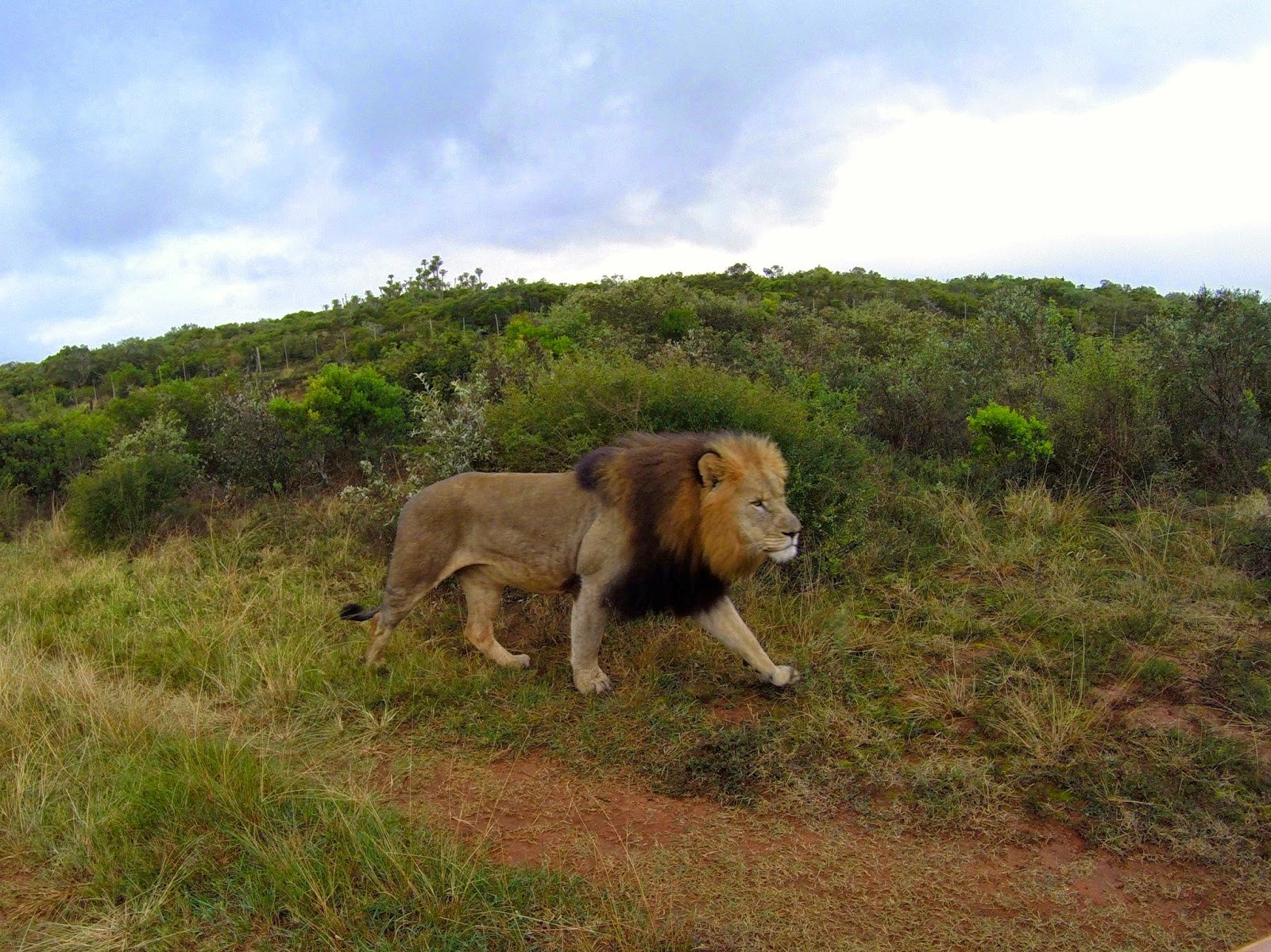
Day 9: The Big Five
It was a crisp, clear morning. Thankfully, Kariega has these fleece lap blankets that they provide during the drive. Despite it being July, it’s South African winter and the temperature range is 45-60 degrees. Ken and I each snuggled up as we went out looking for more elephants. We encountered two elephant bulls grazing on some trees, an impala herd, zebra, giraffe, a jackal and some surly looking cape buffalo. Cape buffalo are the thugs of the Big Five animal group. The ‘Big Five’ refers to the most difficult South African animals to hunt on foot, according to game hunters of olden times. The other animals are the lion, elephant, rhinoceros and leopard.
Day 10: Last day on the reserve ... Epic!
All I can say is: epic morning drive! We sought out the lions and lucky for us Louis found them before the other rangers did. So it was just Ken, Louis and me with the lion pride. Several lionesses and the dominant male bathed in the warm morning light. We even got to see a young brother and sister play-fight near a watering hole. Lions don’t like water so they appeared to be trying to shove each other in. I guess that behavior transcends many species.
With lions off the list, we went in search of elephants. We rode to a remote corner of the west side of Kareiga’s property. The smell of elephant dung was fresh so we knew we were close. Incidentally, the reserve roads are covered in animal feces and if you’re wondering, elephants poop a lot.
Driving through the reserve with all the various vegetation and endless maze of roads makes it feel like after every turn, you could stumble across something truly magical. This time it finally happened. We came upon a watering hole and there, sipping some delicious brown water, were four elephants. We sat awhile and watched, then moved back up on the road to discover two more elephants making a lunch of some trees.
If I had ever doubted before, these elephants are calm, happy and living as elephants should. We quietly watched that scene. Suddenly, more elephants emerged from the thick tree line in front of us — and not just a few — I believe it was the rest of the herd (for a total of 20-25 animals). We sat stunned as the huge matriarch marched within a few feet of the Jeep. Several babies and adolescents joined the adults on their way to the watering hole as well. To see such large animals so close and to feel them go about their business unthreatened and unstressed just made my life. We circled back to the watering hole where almost all of the elephants had gathered, letting the scene just sink in.
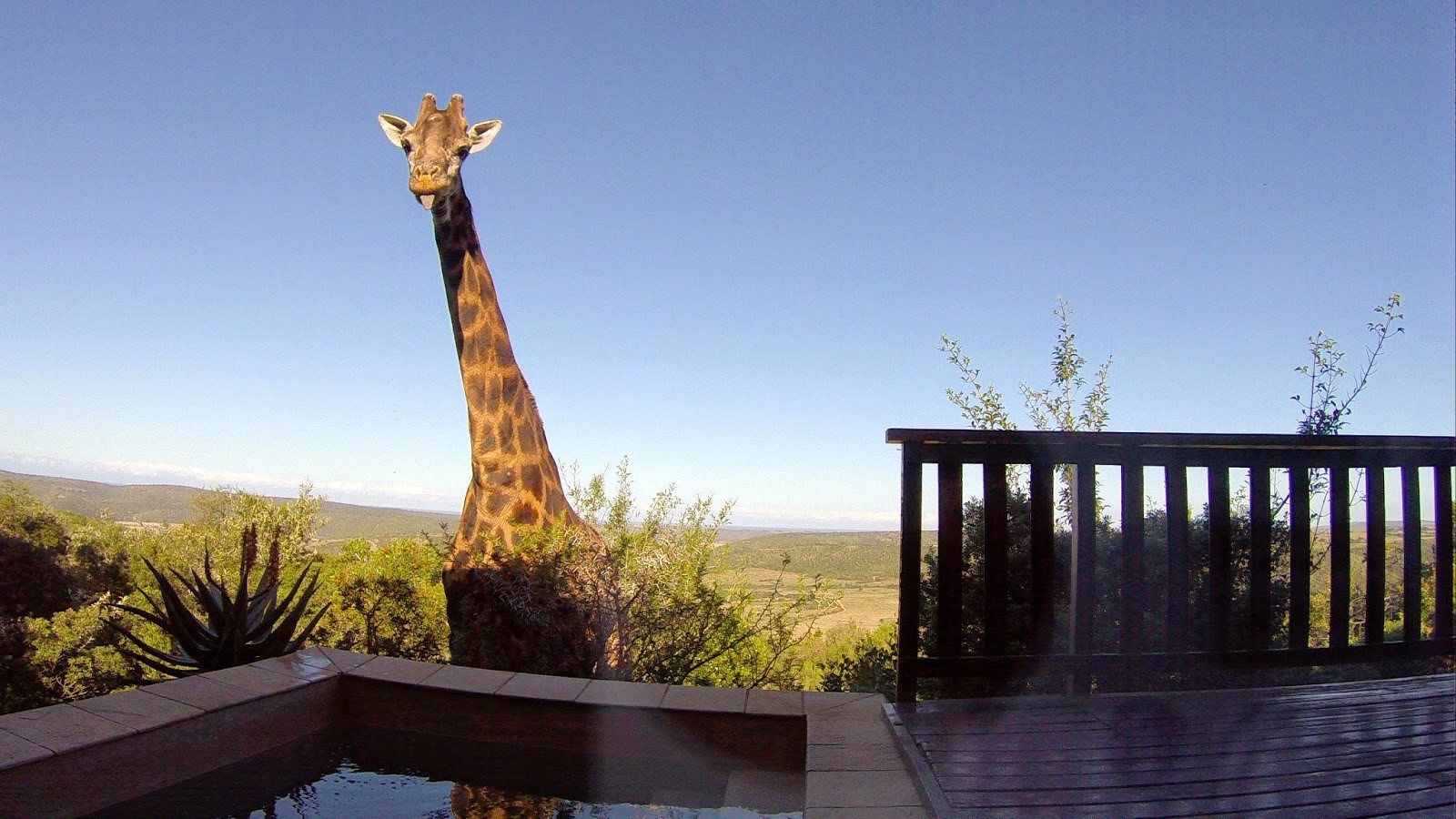
If that wasn’t incredible enough, after we returned to the lodge, Ken and I sat working on our computers in our room until Ken noticed something out on the porch. We have a small soaking pool (very cold this time of year) and as I looked out the window, my brain tried to makes sense of what I was seeing. Despite a big gate (open during the day for jeeps) and a narrow funnel opening to keep the animals out of the lodge/chalet area, a giraffe had wandered in. But of all the 10 chalets it could choose to drink from, we were the lucky ones. I grabbed a camera and army-crawled to the window. It was initially alarmed but stayed to get some more water then wandered off into the trees. Are you kidding me, is this real life? Wow.
Day 11: Farewell Africa

We slept in for once on the last day of our two week vacation, then the car arrived. As we sped to the airport, thought-provoking sights rolled by: some rundown townships (ghettos), black workers hitchhiking along the road, a random monkey sitting on the highway median and the vast swaths of untamed land. South Africa has such a swirl of history, beauty, danger and contradictions. From the native tribes to the early European explorers to the rise of colonialism and then Apartheid, all have left their marks here, for better and worse. In learning about Nelson Mandela and his struggle against racial segregation and oppression until 1994, when apartheid was finally abolished, means South Africa is still a country putting itself back together. After generations of a significant part of the demographic have been uneducated, mistreated and poverty-stricken, it’s no wonder there is so much crime. On a positive note though, it seems like there is movement in the right direction, albeit slow. It’s heady stuff, but something you can’t ignore when you visit. Lots to ponder on our long flight home. Goodbye South Africa — Totsiens Suid-Afrika!









